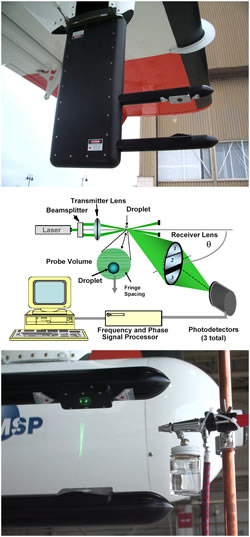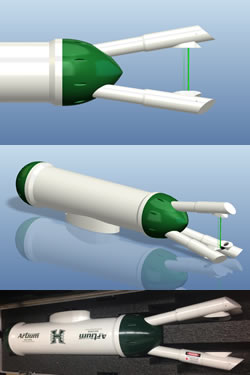Research
Global patterns of aerosol-cloud interactions
Continuing work that began at JPL utilizing a variety of satellites and remotely sensed data, Dr. Small Griswold's current work is focused on improving the understanding of the physical and dynamical processes governing global cloud-aerosol-precipitation interactions. Knowledge of the temporal and spatial variations in these relationships is very important for regional and global climate predictions. In particular, the radiative forcing due to the direct and cloud albedo effects on clouds have a low level of scientific understanding, either slightly or totally offsetting the positive radiative forcing due to greenhouse gases. By clearly identifying the differences between observed (satellite retrieved) and modeled cloud and aerosol spatial and temporal patters we are able to contribute key information for the next generation of parameterizations for global climate models [Sockol and Small Griswold, 2017]. One unique aspect of modern satellite observations is the ability to view atmospheric phenomena with both horizontal and vertical methods. Through the use of vertical profiling satellite born LIDAR we are able to characterize the altitudes at which clouds and aerosols are coincident [Heikkila and Small Griswold, in preparation]. The results allow her and her group to identify key regions for in-depth analysis, field project planning, and provide validation for the global and regional climate models.
-
Weather Impacts on Aviation
- A key intersection of my research interests and society is aviation and how weather and climate impact operations. When factoring in weather impacts on the National Airspace System delays, weather was responsible for 32.6% of the total number of delay minutes recorded. Through the use of non-traditional aviation performance metrics and datasets along with hourly weather data her research group was able to ascertain the impact of critical weather phenomena on delays and cancellations for key airports in the US [Goodman and Small Griswold, 2019]. One metric in particular, density altitude, which is related to temperature and pressure and determines if aircraft can safely take off and land, has been of particular interest in the general news media during summer 2017 heat waves in the southwest. The unique analysis assessed the impact of large scale climate variability (e.g. El Niño) on density altitude in the continental US [Goodman and Small Griswold, 2018]. Dr. Small Griswold plans to continue to tackle critical issues in aviation weather such as icing prediction and changes in wind directions and severe weather patterns as a function of a changing climate.
-
Precipitation, Entrainment Mixing and Turbulence in Cumulus and Stratocumulus Clouds
- Multiple data sets acquired using the PDI during field campaigns of maritime and continental cumulus and marine stratocumulus (MSc) allow us to analyze precipitation processes, entrainment mixing, and turbulence over a range of conditions. The PDI is the first instrument to obtain instantaneous droplet arrival times along with size and is the only instrument that can be used to investigate droplet clustering and turbulence. For cumulus clouds, Dr. Small Griswold and her reserach group have found that clustering increases where cloud top entrainment is occurring, [Dodson and Small Griswold, 2019], that clustering is more prominent at the edges of clouds, and that background aerosol concentration was unrelated to clustering [Dodson and Small Griswold, 2019.]. These findings confirm [Small et al., 2013] and contradict [Small et al. 2011] previous work inspiring new research directions. For stratocumulus clouds, research has focused on drizzle production and its impact on the structure of the stratocumulus topped boundary layer, dynamics as well as how air is mixed into (entrainment) and out of (detrainment) the cloud. We have found that both entrainment and detrainment increase with altitude [Norgren et al., 2016] and that the evaporation of drizzle plays a large role in determine boundary layer structure [Rossiter et al., submitted to Q. J. Royal. Met. Soc].
-
-
NEW DIRECTION: Impact of Volcanic Aerosols on Trade Wind Cumulus Clouds and Precipitation
- When developing new research projects, Dr. Small Griswold finds it important to consider how her research can impact local Hawaiian populations and the Hawaiian environment. Her interests in clouds, aerosols, climate and human impacts converge when considering the impact of Kilauea Volcano emissions on clouds precipitation, and air quality. Kilauea is a major contributor to regional air quality and is a uniquely isolated major source of sulfur that emits into an otherwise pristine marine boundary layer, and is thus a unique natural laboratory. We have developed techniques to evaluate the impacts of these emissions on cumulus clouds using high resolution satellite data and global climate models. This preliminary work is the foundation for new proposal to research how the Kilauea plume impacted precipitation down wind of the Hawaiian islands.
-
NEW DIRECTION: Impacts of biomass burning aerosols in stratocumulus clouds
- When considering the importance of clouds in determining global climate, a key area of cutting-edge research is focused on how marine stratocumulus clouds (MSc) are modified by aerosol. Low-level MSc have a strong cooling effect and without these clouds the average temperature of the earth would be higher. Aerosols interacting with MSc clouds can modify structure, lifetime, and their ability to precipitate and impact the radiative and hydrologic balance of the earth. Most recently, Dr. Small Griswold and her research group has been focusing on the Southeast Atlantic MSc Deck which is coincident in time and space with large emissions of biomass burning smoke. These aerosol play multiple roles in modifying the cloud deck through interactions with radiation as absorbing aerosol and through modifications to cloud properties and precipitation processes.
-
NEW DIRECTION: Impact of COVID-19 Pandemic on Global and Regional Aerosol
- As the global community deals with the COVID-19 Pandemic, the original sequence of shutdowns and quarantines provides an interesting opportunity to scrutinze the influence of anthropogenic aerosols on the global aerosol budget. Global and focused regional studies (US, China, and India) allow us to investigate how aerosol levels changed from before, during and after the main shutdowns as compared to a climatilitical average aerosol amount. This work is new and developing and updates will be posted here.
-
FIELD PROJECTS and CAMPAIGNS
- Dr. Small Griswold has been fortunate to participate in numerous field projects using the Phase Doppler Interferometer to study cloud properites and precipitation initiation in warm clouds including continental cumulus, trade wind cumulus and marine stratocumulus. Below is a table breifly describing each field project Dr. SmallGriswold and the PDI instrument have participated in over the last few years.
-
2016-2018
ORACLES (ObseRvations of Aerosols above CLouds and their intEractionS), Science Team member, flying the Flight-Probe Dual Range Phase Doppler Interferometer (FPDR-PDI) on the NASA P-3 in the Southeast Atlantic off the coast of Namibia.
2008
VOCALS (VAMOS Ocean Cloud Atmosphere Land Study), data processing advisor for Phase Doppler Interferometer (PDI) data collected on the Navy CIRPAS Twin Otter, over the Southeast Pacific Ocean off the coast of Chile.
2007
CLASIC (Cloud and Land Surface Interaction Campaign), Science Team member, flying the Phase Doppler Interferometer (PDI) on the Navy CIRPAS Twin Otter, over Ponca City, Oklahoma.
2007
MASE-II (Marine Stratocumulus Experiment-II), Science Team member, flying the Phase Doppler Interferometer (PDI) on the Navy CIRPAS Twin Otter, off the coast of California.
2006
GoMACCS (Gulf of Mexico Atmospheric Composition and Climate Study), Science Team member, flying the Phase Doppler Interferometer (PDI) on the Navy CIRPAS Twin Otter, near Houston Texas and over the Gulf of Mexico.
2005
MASE-I (Marine Stratocumulus Experiment-I), Science Team member, flying the Phase Doppler Interferometer (PDI) on the Navy CIRPAS Twin Otter, off the coast of California.
2004
RICO (Rain in Cumulus over the Ocean), Science Team member, flying the Phase Doppler Interferometer (PDI) on the NCAR C-130 Aircraft off the coast of Antigua, WI.
-

